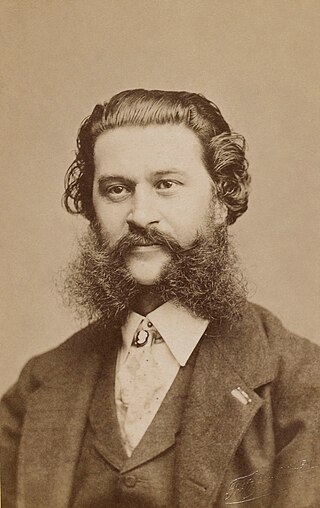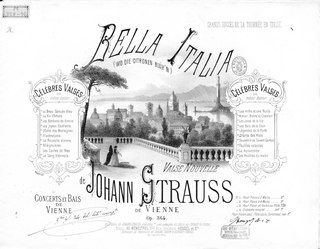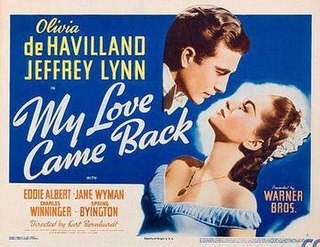
Johann Baptist Strauss II, also known as Johann Strauss Jr., the Younger or the Son, was an Austrian composer of light music, particularly dance music and operettas as well as a violinist. He composed over 500 waltzes, polkas, quadrilles, and other types of dance music, as well as several operettas and a ballet. In his lifetime, he was known as "The Waltz King", and was largely responsible for the popularity of the waltz in Vienna during the 19th century. Some of Johann Strauss's most famous works include "The Blue Danube", "Kaiser-Walzer", "Tales from the Vienna Woods", "Frühlingsstimmen", and the "Tritsch-Tratsch-Polka". Among his operettas, Die Fledermaus and Der Zigeunerbaron are the best known.

"The Blue Danube" is the common English title of "An der schönen blauen Donau", Op. 314, a waltz by the Austrian composer Johann Strauss II, composed in 1866. Originally performed on 15 February 1867 at a concert of the Wiener Männergesang-Verein, it has been one of the most consistently popular pieces of music in the classical repertoire. Its initial performance was considered only a mild success, however, and Strauss is reputed to have said, "The devil take the waltz, my only regret is for the coda—I wish that had been a success!"
Man lebt nur einmal! is a waltz by Johann Strauss II written in 1855. The piece was marked as im Ländlerstyle which in other words means "in the same style as the Ländler", which is an Austrian folk dance. The title was a quotation from Johann Wolfgang von Goethe's 1774 play Clavigo, but it raised a few eyebrows at that time as Vienna was just recovering from a disastrous cholera epidemic and many of the stricken populace may have been superstitious of such a title. Nonetheless, Strauss performed it at the Sperl Ballroom to great acclaim and this waltz has endured lasting appeal even in a simple string arrangement for a quintet consisting of two violins, one viola, one cello, and a double bass.
"Die Publicisten" is a waltz by Johann Strauss II composed in 1868. It was written for the sixth Concordia Ball held in the Sofienbad-Saal on the 4 February of the same year. The waltz's title was an allusion to Vienna's press, with whom he maintained a fruitful partnership that his family had enjoyed since the days of his father Johann Strauss I. The more or less symbiotic association was needed as the musical business of composers would inevitably flourish under favorable press reviews and the establishment of the Vienna Journalists' and Authors' Association in 1859 would signify an even more closer relationship between both composer and the press. The Concordia Ball named after the Roman God of civic concord had its first ball in 1863.
Cagliostro-Walzer op.370 is a waltz by Johann Strauss II composed in 1875 based on themes from his operetta, Cagliostro in Wien which premiered on 27 February 1875 at the famous Theater an der Wien.

"Rosen aus dem Süden", Op. 388, is a waltz medley composed by Johann Strauss II in 1880 with its themes drawn from the operetta Das Spitzentuch der Königin. Strauss dedicated the waltz to King Umberto I of Italy.
Künstlerleben, Op. 316 is a waltz written by Johann Strauss II in 1867, following closely on the success of the popular "The Blue Danube". Austria was severely shaken the previous year 1866 by the crushing defeat that the Austrian army suffered in the Battle of Königgrätz and many of the year's festivities and balls were cancelled as the prevalent depressing mood affected most of Vienna's populace.

Wiener Blut Op. 354 is a waltz by Johann Strauss II first performed by the composer on 22 April 1873. The new dedication waltz was to celebrate the wedding of the Emperor Franz Joseph I's daughter Archduchess Gisela Louise Maria and Prince Leopold of Bavaria. However, the waltz was also chiefly noted by Strauss' biographers as the début of Strauss with the Vienna Philharmonic Orchestra where for many years, the Philharmonic had dismissed any association with the 'Waltz King' as it had not wished to be associated with mere 'light' or 'pops' music. The festival ball celebrating the event was held at the Musikverein Hall which is the venue for the present day Neujahrskonzert.
Karnevalsbotschafter op. 270 is a waltz composed by Johann Strauss II in the autumn of 1862 during his honeymoon with his first wife Henrietta Treffz in Venice. It was first performed at the 50th anniversary celebration of the Vienna's Gesellschaft der Musikfreunde at the 'Sperl' dance hall on 11 November 1862.

"Frühlingsstimmen", Op. 410 is an orchestral waltz, with optional solo soprano voice, written in 1882 by Johann Strauss II.
Schatz-Walzer, Op. 418, is a Viennese waltz by Johann Strauss II composed in 1885. The melodies in this waltz were drawn from Strauss' operetta Der Zigeunerbaron, which premiered to critical acclaim on 24 October 1885. Der Zigeunerbaron, a Hungarian-influenced work, remained Strauss' best-remembered operetta after Die Fledermaus. The waltz version was first performed on 22 November that year in the concert hall of the Vienna Musikverein, with Eduard Strauss conducting.

"Wo die Zitronen blühen", Op. 364, is a waltz by Johann Strauss II written in 1874. The waltz was composed during a tour of the composer in Italy where he travelled with the Langenbach Orchestra of Germany and performed the work at the Teatro Regio in Turin on 9 May 1874.

The "Radetzky March", Op. 228, is a march composed by Johann Strauss (Senior) which was first performed on 31 August 1848 in Vienna to celebrate the victory of the Austrian Empire under Field Marshal Joseph Radetzky von Radetz over the Italian forces at the Battle of Custoza, during the First Italian War of Independence. It has been noted that its tone is more celebratory than martial, but nevertheless it soon became popular among regimented marching soldiers.

My Love Came Back is a 1940 American comedy-drama film directed by Curtis Bernhardt and starring Olivia de Havilland, Jeffrey Lynn, Eddie Albert, and Jane Wyman. Based on the 1935 Austrian film Episode written and directed by Walter Reisch, the film is about a gifted young violinist who considers leaving a prestigious music academy to play in a jazz band to earn money. The academy's new president—a distinguished wealthy patron of the arts—convinces her to stay after secretly arranging a scholarship for her out of his own pocket, and the two begin attending concerts together. Complications arise when he asks his young business manager to take his place at one of the concerts. The film is notable for Heinz Eric Roemheld's musical direction and Ray Heindorf's unique swing orchestral arrangements of classical pieces. My Love Came Back was released by Warner Bros. Pictures in the United States on July 13, 1940.
Tales from the Vienna Woods is a play by Austro-Hungarian writer Ödön von Horváth.

Tales from the Vienna Woods is a 1928 German silent film directed by Jaap Speyer and starring Albert Paulig, Magnus Stifter, and Eric Barclay. The title refers to the waltz Tales from the Vienna Woods by Johann Strauss.

Tales from the Vienna Woods is a 1934 Austrian musical film directed by Georg Jacoby and starring Magda Schneider, Wolf Albach-Retty and Leo Slezak. The title refers to the waltz Tales from the Vienna Woods by Johann Strauss.
Tales from the Vienna Woods is a waltz by Johann Strauss II.











